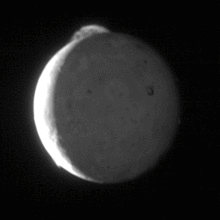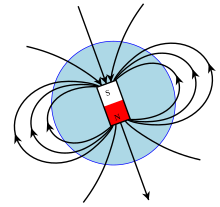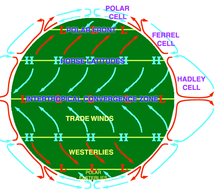Theoretical planetology: Difference between revisions
spelling correction |
Converting bare references using Reflinks |
||
| Line 10: | Line 10: | ||
{{FixBunching|end}} |
{{FixBunching|end}} |
||
'''Theoretical planetology''', also known as '''theoretical planetary science'''<ref>http://pr.caltech.edu/media/Press_Releases/PR12525.html</ref> is a branch of [[planetary sciences]] that developed in the 20th century.<ref name="yugoplanet">http://arxiv.org/abs/astro-ph/0005117</ref> |
'''Theoretical planetology''', also known as '''theoretical planetary science'''<ref>[http://pr.caltech.edu/media/Press_Releases/PR12525.html ]{{dead link|date=May 2009}}</ref> is a branch of [[planetary sciences]] that developed in the 20th century.<ref name="yugoplanet">http://arxiv.org/abs/astro-ph/0005117</ref> |
||
== Nature of the work == |
== Nature of the work == |
||
| Line 16: | Line 16: | ||
Theoretical planetologists, also known as theoretical planetary scientists, use [[modelling]] techniques to develop an understanding of the internal structure of [[planet]]s by making assumptions about their [[chemical]] composition and the state of their [[material]]s, then calculating the radial distribution of various properties such as [[temperature]], [[pressure]], or [[density]] of material across the planet's internals.<ref name="yugoplanet"/> |
Theoretical planetologists, also known as theoretical planetary scientists, use [[modelling]] techniques to develop an understanding of the internal structure of [[planet]]s by making assumptions about their [[chemical]] composition and the state of their [[material]]s, then calculating the radial distribution of various properties such as [[temperature]], [[pressure]], or [[density]] of material across the planet's internals.<ref name="yugoplanet"/> |
||
Theoretical planetologists also use [[numerical]] models to understand how the [[solar system]] planets where formed and develop in the future, their [[thermal]] evolution, their [[tectonics]], how [[magnetic field]]s are formed in planetary interiors, how [[convection]] processes work in the [[Planetary core|cores]] and [[mantle]]s of [[terrestrial planet]]s and in the interiors of [[gas giants]], how their [[lithosphere]]s deform, the [[orbit]]al dynamics of planetary satellites, how [[dust]] and [[ice]] is transported on the surface of some planets (such as [[Mars]]), and how the [[atmospheric circulation]] takes place over a planet.<ref name="uclaplanet">http://www.ess.ucla.edu/research/planet_physics.asp</ref> |
Theoretical planetologists also use [[numerical]] models to understand how the [[solar system]] planets where formed and develop in the future, their [[thermal]] evolution, their [[tectonics]], how [[magnetic field]]s are formed in planetary interiors, how [[convection]] processes work in the [[Planetary core|cores]] and [[mantle]]s of [[terrestrial planet]]s and in the interiors of [[gas giants]], how their [[lithosphere]]s deform, the [[orbit]]al dynamics of planetary satellites, how [[dust]] and [[ice]] is transported on the surface of some planets (such as [[Mars]]), and how the [[atmospheric circulation]] takes place over a planet.<ref name="uclaplanet">{{cite web|url=http://www.ess.ucla.edu/research/planet_physics.asp |title=UCLA - Earth and Space Sciences - Research in Planetary Physics |publisher=Ess.ucla.edu |date=2008-04-16 |accessdate=2009-05-21}}</ref> |
||
Theoretical planetologists may use [[laboratory]] [[experiment]]s to understand various phenomena analogous to planetary processes, such as convection in rotating fluids.<ref name="uclaplanet"/> |
Theoretical planetologists may use [[laboratory]] [[experiment]]s to understand various phenomena analogous to planetary processes, such as convection in rotating fluids.<ref name="uclaplanet"/> |
||
Theoretical planetologists make extensive use of basic [[physics]], particularly [[fluid dynamics]] and [[condensed matter physics]], and much of their work involves interpretation of [[data]] returned by [[space missions]], although they rarely get actively involved in them.<ref name="stevenson">http://www.planetary.caltech.edu/faculty/stevenson/</ref> |
Theoretical planetologists make extensive use of basic [[physics]], particularly [[fluid dynamics]] and [[condensed matter physics]], and much of their work involves interpretation of [[data]] returned by [[space missions]], although they rarely get actively involved in them.<ref name="stevenson">[http://www.planetary.caltech.edu/faculty/stevenson/ ]{{dead link|date=May 2009}}</ref> |
||
== Educational requirements == |
== Educational requirements == |
||
Typically a theoretical planetologist will have to have had [[higher education]] in [[physics]] and [[theoretical physics]], at [[PhD]] doctorate level.<ref>http://www.planetary.caltech.edu/faculty/stevenson/cv.html</ref><ref>http://mr.caltech.edu/media/Press_Releases/PR12525.html</ref> |
Typically a theoretical planetologist will have to have had [[higher education]] in [[physics]] and [[theoretical physics]], at [[PhD]] doctorate level.<ref>[http://www.planetary.caltech.edu/faculty/stevenson/cv.html ]{{dead link|date=May 2009}}</ref><ref>{{cite web|author=Media Relations |url=http://mr.caltech.edu/media/Press_Releases/PR12525.html |title=Four from Caltech Named to National Academy of Sciences - Caltech |publisher=Mr.caltech.edu |date=2007-11-14 |accessdate=2009-05-21}}</ref> |
||
== Scientific visualisation == |
== Scientific visualisation == |
||
Because of the use of [[scientific visualisation]] animation, theoretical planetology has a relationship with [[computer graphics]]. Example movies exhibiting this relation are the 4-minute "[[The Origin of the Moon (scientific visualisation movie)|The Origin of the Moon]]"<ref name="visualisation">http://www.olats.org/space/13avril/2002/space13Avr2002.html</ref> |
Because of the use of [[scientific visualisation]] animation, theoretical planetology has a relationship with [[computer graphics]]. Example movies exhibiting this relation are the 4-minute "[[The Origin of the Moon (scientific visualisation movie)|The Origin of the Moon]]"<ref name="visualisation">{{cite web|url=http://www.olats.org/space/13avril/2002/space13Avr2002.html |title=Présentation de la journée |publisher=Olats.org |date= |accessdate=2009-05-21}}</ref> |
||
== Major successes == |
== Major successes == |
||
One of the major successes of theoretical planetology is the prediction and subsequent confirmation of [[volcanism on Io]].<ref name="encyclopedia">Encyclopedia of Space Science and Technology by Hans Mark (book), page 883, accessed through Google Books Search: http://books.google.com/books?id=xo9UAAAAMAAJ&q=%22one+of+the+major+success+stories+in+theoretical+planetary+science%22&dq=%22one+of+the+major+success+stories+in+theoretical+planetary+science%22&lr=&pgis=1</ref><ref name="prediction">http://www.solarviews.com/eng/iovolcano.htm</ref> |
One of the major successes of theoretical planetology is the prediction and subsequent confirmation of [[volcanism on Io]].<ref name="encyclopedia">Encyclopedia of Space Science and Technology by Hans Mark (book), page 883, accessed through Google Books Search: http://books.google.com/books?id=xo9UAAAAMAAJ&q=%22one+of+the+major+success+stories+in+theoretical+planetary+science%22&dq=%22one+of+the+major+success+stories+in+theoretical+planetary+science%22&lr=&pgis=1</ref><ref name="prediction">{{cite web|url=http://www.solarviews.com/eng/iovolcano.htm |title=Io's Volcanic Features |publisher=Solarviews.com |date=1979-03-08 |accessdate=2009-05-21}}</ref> |
||
The prediction was made by [[Stanton Peale]] who wrote a [[scientific paper]] claiming that Io must be volcanically active that was published one week before [[Voyager 1]] encountered [[Jupiter]]. When Voyager 1 photographed Io in 1979, his theory was confirmed.<ref name="prediction"/> Later photographs of Io by the [[Hubble Space Telescope]] and from the ground also showed volcanoes on Io's surface, and they were extensively studied and photographed by the [[Galileo]] orbiter of Jupiter from 1995-2003. |
The prediction was made by [[Stanton Peale]] who wrote a [[scientific paper]] claiming that Io must be volcanically active that was published one week before [[Voyager 1]] encountered [[Jupiter]]. When Voyager 1 photographed Io in 1979, his theory was confirmed.<ref name="prediction"/> Later photographs of Io by the [[Hubble Space Telescope]] and from the ground also showed volcanoes on Io's surface, and they were extensively studied and photographed by the [[Galileo]] orbiter of Jupiter from 1995-2003. |
||
| Line 38: | Line 38: | ||
== Criticism == |
== Criticism == |
||
[[D. C. Tozer]] of [[University of Newcastle upon Tyne]]<ref>http://www.springerlink.com/content/v825593642193766/</ref> |
[[D. C. Tozer]] of [[University of Newcastle upon Tyne]],<ref>{{cite web|url=http://www.springerlink.com/content/v825593642193766/ |title=Journal Article |doi=10.1007/BF00565402 |publisher=SpringerLink |date= |accessdate=2009-05-21}}</ref> writing in 1974, expressed the opinion that "it could and will be said that theoretical planetary science is a waste of time" until problems related to "sampling and scaling" are resolved, even though these problems cannot be solved by simply collecting further laboratory data.<ref>[http://adsabs.harvard.edu/abs/1982AREPS..10..257S (page 169)]</ref> |
||
== Researchers == |
== Researchers == |
||
| Line 44: | Line 44: | ||
[[Researcher]]s working on theoretical planetology include: |
[[Researcher]]s working on theoretical planetology include: |
||
* [[David J. Stevenson]]<ref name="stevenson"/> |
* [[David J. Stevenson]]<ref name="stevenson"/> |
||
* [[Jonathan Lunine]] ([[University of Arizona]] professor of theoretical planetology and physics, and [[Cassini]] mission scientist specialising on [[Titan (moon)|Titan]])<ref>http://www.tucsoncitizen.com/daily/local/26250.php</ref><ref>http://sse.jpl.nasa.gov/news/display.cfm?News_ID=9999</ref> |
* [[Jonathan Lunine]] ([[University of Arizona]] professor of theoretical planetology and physics, and [[Cassini]] mission scientist specialising on [[Titan (moon)|Titan]])<ref>{{cite web|author=By LARRY COPENHAVER Tucson Citizen |url=http://www.tucsoncitizen.com/daily/local/26250.php |title=Small 'scope used in discovery of new planet |publisher=Tucsoncitizen.com |date=2006-09-15 |accessdate=2009-05-21}}</ref><ref>{{cite web|url=http://sse.jpl.nasa.gov/news/display.cfm?News_ID=9999 |title=Solar System Exploration: News & Events: News Archive |publisher=Sse.jpl.nasa.gov |date= |accessdate=2009-05-21}}</ref> |
||
==References == |
==References == |
||
Revision as of 03:24, 21 May 2009



Theoretical planetology, also known as theoretical planetary science[7] is a branch of planetary sciences that developed in the 20th century.[8]
Nature of the work
Theoretical planetologists, also known as theoretical planetary scientists, use modelling techniques to develop an understanding of the internal structure of planets by making assumptions about their chemical composition and the state of their materials, then calculating the radial distribution of various properties such as temperature, pressure, or density of material across the planet's internals.[8]
Theoretical planetologists also use numerical models to understand how the solar system planets where formed and develop in the future, their thermal evolution, their tectonics, how magnetic fields are formed in planetary interiors, how convection processes work in the cores and mantles of terrestrial planets and in the interiors of gas giants, how their lithospheres deform, the orbital dynamics of planetary satellites, how dust and ice is transported on the surface of some planets (such as Mars), and how the atmospheric circulation takes place over a planet.[3]
Theoretical planetologists may use laboratory experiments to understand various phenomena analogous to planetary processes, such as convection in rotating fluids.[3]
Theoretical planetologists make extensive use of basic physics, particularly fluid dynamics and condensed matter physics, and much of their work involves interpretation of data returned by space missions, although they rarely get actively involved in them.[5]
Educational requirements
Typically a theoretical planetologist will have to have had higher education in physics and theoretical physics, at PhD doctorate level.[9][10]
Scientific visualisation
Because of the use of scientific visualisation animation, theoretical planetology has a relationship with computer graphics. Example movies exhibiting this relation are the 4-minute "The Origin of the Moon"[6]
Major successes
One of the major successes of theoretical planetology is the prediction and subsequent confirmation of volcanism on Io.[1][2]
The prediction was made by Stanton Peale who wrote a scientific paper claiming that Io must be volcanically active that was published one week before Voyager 1 encountered Jupiter. When Voyager 1 photographed Io in 1979, his theory was confirmed.[2] Later photographs of Io by the Hubble Space Telescope and from the ground also showed volcanoes on Io's surface, and they were extensively studied and photographed by the Galileo orbiter of Jupiter from 1995-2003.
Criticism
D. C. Tozer of University of Newcastle upon Tyne,[11] writing in 1974, expressed the opinion that "it could and will be said that theoretical planetary science is a waste of time" until problems related to "sampling and scaling" are resolved, even though these problems cannot be solved by simply collecting further laboratory data.[12]
Researchers
Researchers working on theoretical planetology include:
- David J. Stevenson[5]
- Jonathan Lunine (University of Arizona professor of theoretical planetology and physics, and Cassini mission scientist specialising on Titan)[13][14]
References
- ^ a b Encyclopedia of Space Science and Technology by Hans Mark (book), page 883, accessed through Google Books Search: http://books.google.com/books?id=xo9UAAAAMAAJ&q=%22one+of+the+major+success+stories+in+theoretical+planetary+science%22&dq=%22one+of+the+major+success+stories+in+theoretical+planetary+science%22&lr=&pgis=1
- ^ a b c "Io's Volcanic Features". Solarviews.com. 1979-03-08. Retrieved 2009-05-21.
- ^ a b c "UCLA - Earth and Space Sciences - Research in Planetary Physics". Ess.ucla.edu. 2008-04-16. Retrieved 2009-05-21.
- ^ Visualizations that have been created with VisIt. at wci.llnl.gov. Updated: November 8, 2007
- ^ a b c [1][dead link]
- ^ a b "Présentation de la journée". Olats.org. Retrieved 2009-05-21.
- ^ [2][dead link]
- ^ a b http://arxiv.org/abs/astro-ph/0005117
- ^ [3][dead link]
- ^ Media Relations (2007-11-14). "Four from Caltech Named to National Academy of Sciences - Caltech". Mr.caltech.edu. Retrieved 2009-05-21.
- ^ "Journal Article". SpringerLink. doi:10.1007/BF00565402. Retrieved 2009-05-21.
- ^ (page 169)
- ^ By LARRY COPENHAVER Tucson Citizen (2006-09-15). "Small 'scope used in discovery of new planet". Tucsoncitizen.com. Retrieved 2009-05-21.
- ^ "Solar System Exploration: News & Events: News Archive". Sse.jpl.nasa.gov. Retrieved 2009-05-21.
See also
External links
- TMO Interview - Why Does A Rocket Scientist Use A Mac?, features theoretical planetologist David J. Stevenson
